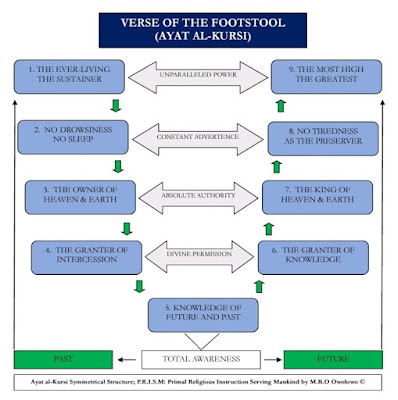Symmetrical Structure of Ayat al-Kursi (Verse of The Footstool)
Symmetrical Structure of Ayat al-Kursi (Verse of The Footstool)
The most powerful Ayah in the Quran is Ayat al-Kursi aka Ayatul Kursi and is commonly translated as Verse of The Throne. Though allegorical, it is more linguistically accurate to translate as Verse of The Footstool; where Kursi represents 'Footstool' instead of 'Throne' – which literally means Arsh. Ayatul Kursi is embedded within Surah Baqarah; which is the longest Surah of the entire Quran – Chapter 2 (The Cow). Baqarah has 286 verses, and the verse of the throne is verse 255.
Allah! There is no god ˹worthy of
worship˺ except Him, the Ever-Living, All-Sustaining. Neither drowsiness nor
sleep overtakes Him. To Him belongs whatever is in the heavens and whatever is
on the earth. Who could possibly intercede with Him without His permission? He
˹fully˺ knows what is ahead of them and what is behind them, but no one can
grasp any of His knowledge—except what He wills ˹to reveal˺. His Seat
encompasses the heavens and the earth, and the preservation of both does not
tire Him. For He is the Most High, the Greatest. – Quran 2:255
Thematic Analysis: A thematic analysis of Ayat al-Kursi reveals nine interrelated sections.
1. The Ever-Living, The Sustainer
(Unparalleled Power)
2. No Drowsiness, No Sleep (Constant
Advertence)
3. The Owner of Heaven and Earth (Absolute
Authority)
4. The Granter of Intercession (Divine
Permission)
5. Total Awareness (Knowledge of Future
and Past; Prevenient and Subsequent; Ahead and Behind)
6. The Granter of Knowledge (Divine
Permission)
7. The King of Heaven and Earth (Absolute
Authority)
8. No Tiredness as The Preserver
(Constant Advertence)
9. The Most High, The Greatest
(Unparalleled Power)
Theme 1: Unparalleled Power (1 and
9)
Theme 2: Constant Advertence (2 and
8)
Theme 3: Absolute Authority (3 and
7)
Theme 4: Divine Permission (4 and
6)
Theme 5: Total Awareness (5)
Explanation: Theme 5 doubles as Section 5 and is strategically placed at the centre to represent an awareness of sections 1- 4 and sections 6-9 (knowledge of what is ahead and behind).
Illustrative Depiction: An illustration of the symmetrical phenomenon.
 |
| Ayat al-Kursi Symmetrical Structure |
From a linguistic perspective, the
thematic structure in the Verse of the Footstool (Ayatul Kursi) is unique and
impossible to execute, whilst maintaining its contextuality in relation to its
location. The execution becomes more remarkable, considering the Quran was not
initially written down but recited during revelation.
Excerpt from pages 264-267 of P.R.I.S.M: Primal Religious Instruction Serving Mankind by M.B.O Owolowo ©



Comments
Post a Comment